卡板冲压工艺及模具设计(含CAD零件图装配图)
无需注册登录,支付后按照提示操作即可获取该资料.
卡板冲压工艺及模具设计(含CAD零件图装配图)(开题报告,中期检查,论文说明书20000字,CAD图纸18张)
内容提要
模具工业是现代工业发展的基础,冲压模具是模具工业的重要组成部分。近年来,与机械相关的各个行业都越来越重视模具的设计与应用,不仅是因为模具已发展成为一项比较成熟的共性技术,同时还因为模具在现代工业中发挥越来越重要的作用。
在这次毕业设计中,先介绍了卡板的结构,对其工艺特点进行分析,再根据其结构特点对模具进行设计。其中重点阐述了成形该零件的级进模的排样设计、工位设计、模具总体结构设计、模具凸、凹模设计、固定板设计及抬顶料装置、卸料板结构及各零部件材料、热处理技术要求等。还介绍了单工序弯曲模的设计。该模具结构简单,加工质量好,生产效率高。
设计过程中,不可避免的遇到一些困难,但是通过努力最终得以解决。这次设计是对模具设计的一次全面实践,相信对未来自己从事的工作一定会有相当大的帮助。
关键字:冲压模具,卡板,级进模
Abstract
The mould industry is the foundation of the modernization industry, and stamping die plays a very important part in die industry. In recent years, each industry that related with mechanics is all paying more and more attention to the design and application of mould. That is not only because mould has already been developed into one ripe generality technology, but also because mould plays a more and more important role in modernization industry.
In the graduation project, the structure of clip board is introduced at first. The technological characteristics of the clip board is analyzed. The die of the clip board is designed according to its structural characteristics. The layout design of the progressive die for forming the part and the designs of the work positions, general structure of the die, the punch and matrix of the progressive die, retaining plate, the structure of the block lifting device, the structure of the stripping plate, and the technical requirements for the material and heat treatment of each component are mainly stated. In addition, the design of the single-operation die for bending is introduced. The die structure is simple, the processing quality of the die is good and the productivity is high.
During the design, unavoidable I met some difficulties in the design, but I have conquered them with my assiduity. It’s my first time to practice of the
design of mold, so I believe that it will be great helpful for my job in the future.
Keyword:stamping die,clip board ,the progressive die
工件如图所示,材料为Q195,厚度为2mm,图中所注尺寸精度均为IT14,工件需大批量生产。
设计目的:通过对卡板的工艺分析,确定出具体的模具加工方法,从而利用模具加工的下述优点:即
1. 模具的适应性强
2. 模具的生产效率高,节约原材料
3. 模具生产的零件制品互换性好
4. 操作工艺简单
5. 模具社会效益好
此次设计的主要内容有:方案的构思,可行性设计,结构设计及对未知问题的探索和解决方案的初步设计,装配图、零件图等一系列图纸的设计与绘制,最后包括毕业设计说明书的完成。
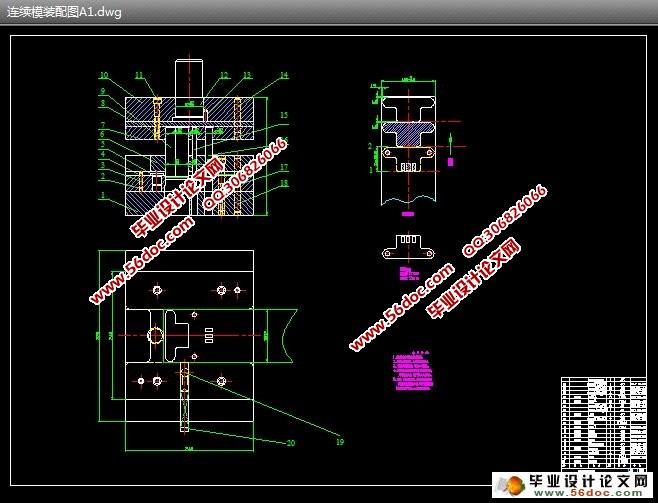
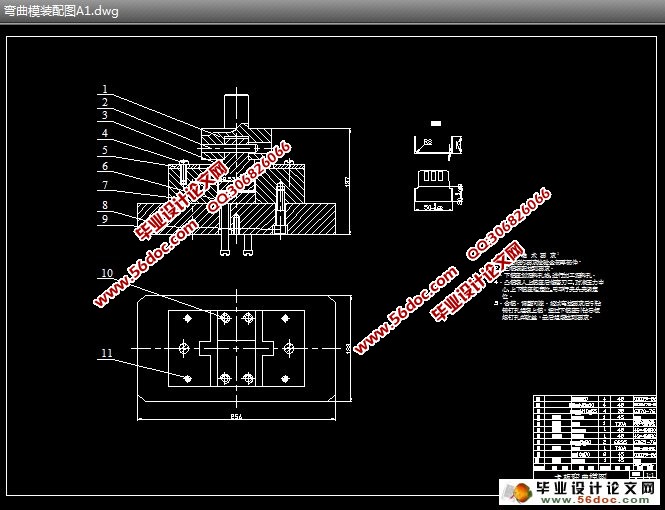
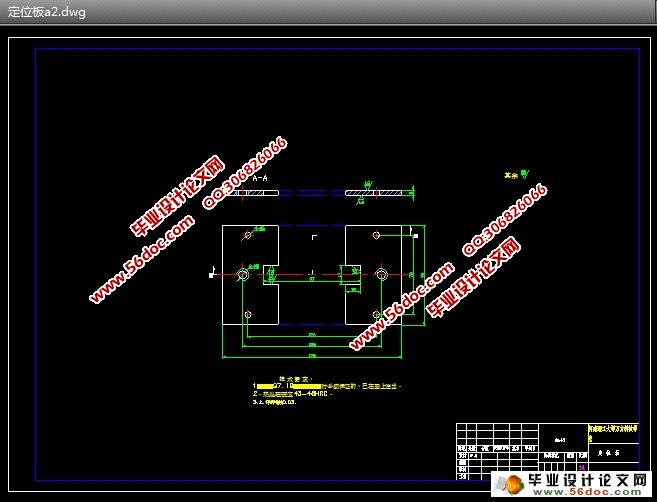
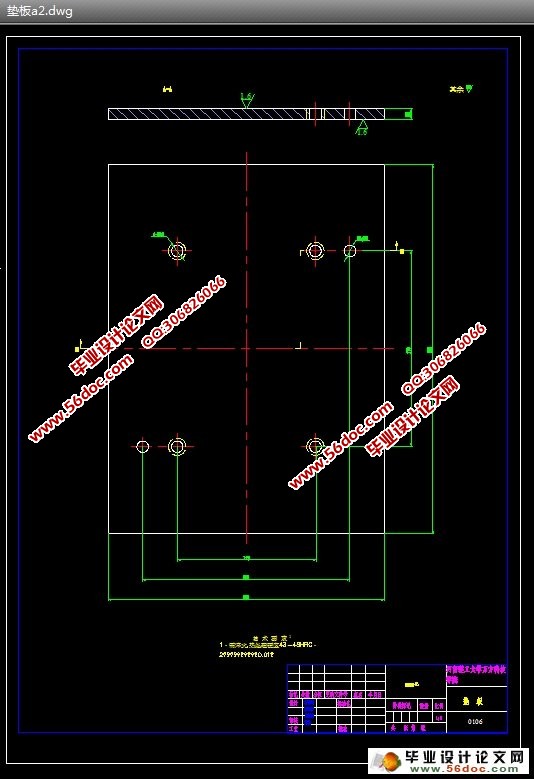
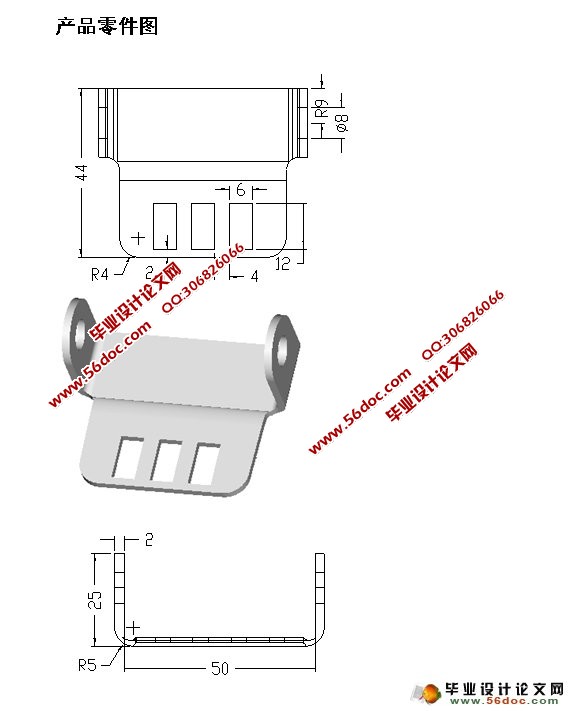
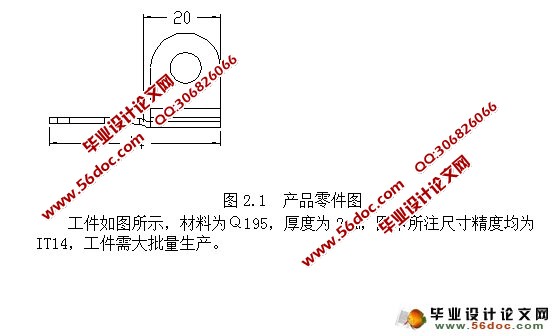
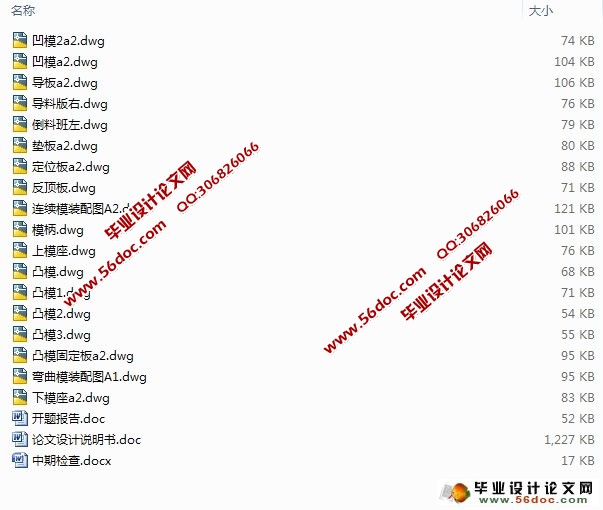
前 言 1
1 绪论 3
1.1 我国冲压模具业发展现状 3
1.2我国冲压模具制造技术发展趋势 4
2零件工艺分析及确定工艺方案和模具结构类型 7
2.1 产品零件图 7
2.2 工艺分析 9
2.2.1 工艺审核 9
2.2.2工件工艺分析 10
2.3 工艺方案及模具结构类型 11
2.3.1.冷冲模类型与结构 11
2.3.2 冲裁模冲裁工艺过程(即冲裁原理) 13
2.3.3 零件方案确定 14
3 连续模 15
3.1 半成品零件图 15
3.2连续模的工作原理 16
3.3工件工艺分析 17
3.4工艺方案及模具结构类型 17
3.5排样设计 18
3.5.1排样的设计 18
3.5.2最小工艺搭边值的选择 19
3.5.3. 送料步距的计算 19
3.5.4. 条料宽度的计算 20
3.6 确定条料利用率 21
3.7 裁板方式 22
3.8计算冲裁力 22
3.8.1.冲裁力的计算 22
3.8.2卸料力、推件力、顶件力的计算 23
3.9模压力中心的确定 25
4 连续模零、部件结构设计 29
4.1 凸、凹模结构设计 29
4.1.1 凸模 29
4.1.2 凹模 32
4.1.3凸、凹模工作尺寸计算 34
4.2定位形式与结构设计 39
4.2.1设计原则 39
4.2.2定位零件机构与应用 40
4.3卸料结构设计 42
4.4连续模导向、安装和有关零、部件 43
4.4.1导向 43
4.4.2结构件与安装 43
4.4.3紧固件选用 45
4.4.4模具自制零件的材料及热处理要求 46
5 压力机的选用与校核 47
6 弯曲模设计计算 49
6.1弯曲的基本原理 49
6.1.1 弯曲工艺的概念及弯曲件 49
6.1.2弯曲的基本原理: 49
6.3弯曲件的工艺性 52
6.4弯曲力的计算 53
6.4.1 弯曲力的计算 53
6.4.2弯曲用压力机的额定压力的确定 54
6.5弯曲件的回弹 54
6.6弯曲模工作部分尺寸的确定 55
6.6.1凸、凹模圆角半径 55
6.6.2凹模深度 56
6.6.3凸、凹模间隙 56
6.6.4凸、凹模工作部分尺寸与公差 56
6.7弯曲模零件总体尺寸的确定 56
6.7.1凸、凹模尺寸 56
6.7.2上、下模座尺寸 57
6.7.3反顶板尺寸 57
6.7.4定位板尺寸 57
6.7.5紧固件选用 57
6.7.5模具自制零件的材料及热处理要求 58
7 模具装配 58
总 结 60
参考文献 61
致 谢 62
